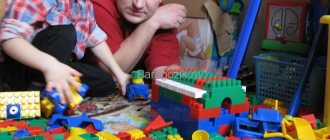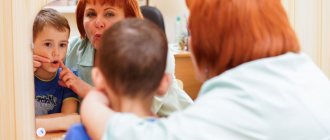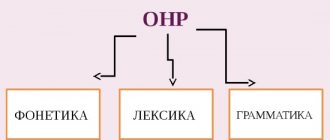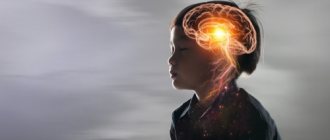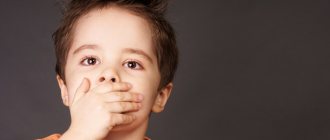Speech therapy presentation for a child with level 1–2 OHP, motor alalia
Irina Shabalina
Speech therapy presentation for a child with level 1–2 OHP, motor alalia
Speech therapy presentation (3-5 years)
Date of examination: "XX"
September 20XX
Child's full name : Alena Ivanova
Home address:
Date of birth: "XX"
November 20XX
What program does it study in: AOEP for children with STD
Age at the time of examination: 4 years 5 months
Parents' request: identifying the level of speech development
1.Speech environment: no features
2. Brief anamnesis:
3.Early speech development: humming at 4 months. ; babbling at 6 months ; word in 1.6; phrase at 4 years old.
When speech impairments were noticed: from 2 years of age
Classes with a speech therapist in preschool age: from 3 years old occasionally.
Hearing: normal
Vision: normal
Features of the child's : easily makes contact, sociable, gets angry if she is not understood.
4. Level of development of active speech: active babbling speech. Pre-grammatical stage of speech development. Uses sentences of both 1-2 and 3-4 amorphous root words.
5. General sound of speech: partially understandable to others, depending on the situation; breathing - without any peculiarities; tempo - without any peculiarities, uses simple intonations; the voice is loud.
6. Sound side of speech:
Articulatory apparatus:
Structure: without features;
Motor function: not examined.
Sound pronunciation: not examined.
Syllabic structure of the word : rough syllabic elision , simplifies all words to 1-2 straight syllables , does not pronounce consonant clusters. In words of one syllable the syllabic structure is not broken, 2 straight syllables - the number of syllables is reproduced unstably (can be simplified to one syllable, 3 straight syllables - isolated cases of use, atypical substitutions.
Phonemic hearing: impaired; when repeating chains of syllables with oppositional sounds, he makes multiple errors in differentiating between voiced and voiceless sounds, while trying to differentiate words that sound similar in sound - no errors.
7.Vocabulary: not appropriate for age, uses mostly babbling words, a small number of common words, sound complexes with polymorphic meaning, nominative nature of the vocabulary; atypical accumulation of vocabulary - uses some generalizing words, feature words, antonyms
8.Grammatical structure of speech: pre-grammatical stage, sentences of both 1-2 and 3-4 amorphous root words predominate.
9. Impressive speech: predicative level . Understands the category of number of nouns, makes isolated errors in understanding prepositional constructions , and differentiates simple case questions.
10. Speech features associated with stuttering: none
Conclusion: OHP level 1-2, motor alalia .
Recommendations: continue speech therapy work on the development of all aspects of speech according to AOEP for children with SLI.
Full name of the speech therapist :
Brief characteristics and classification
Alalia is a partial or complete absence of speech in children with intact hearing. The appearance of this defect is due to underdevelopment or damage to the speech areas of the brain. Alalia is considered one of the most difficult speech disorders, because without the help of a speech therapist, the child does not develop means of communication.
There are two types of alalia, differing in the mechanisms of formation:
- Motor alalia is when a child understands speech addressed to him, but cannot respond independently. Parents often say about such children that they understand everything, but cannot answer.
- Sensory - not only the mechanism of speech reproduction is impaired in the child, but also its perception. That is, he does not understand what others are saying. A characteristic feature of this form is echolalia - the child automatically repeats the words and phrases of those around him.
Parents should contact a specialist if their child:
- Does not answer when called and does not pay attention to the speech of others. But it reacts to non-speech and quiet sounds (creaking, rustling of paper).
- Does not listen to speech, as is typical for hearing-impaired children.
- Does not try to understand what is being said to him and does not use facial expressions or gestures to communicate.
To correct any form of alalia, you need to contact a specialist. This will allow the baby to form all the speech components and help him use them when communicating with others.
How to practice at home on your own
Parents are integral participants in the correction process. They must do articulation gymnastics every day - the complex is given by a speech therapist. In the process of automating sounds or consolidating lexical topics, they perform various homework assignments.
Be sure to develop sensory skills. To do this, use bowls with cereals, sand and other materials. Small toys are placed in them and the child is invited to find them. For fine motor skills, appliqué, modeling, drawing, picking, etc. are useful.
General motor skills develop in outdoor games. On the playground it is useful to ride down the slide, spin on the carousel and climb special ladders. Impressions stimulate the nervous system and its development.
With coordinated work between specialists and parents, alalia is completely curable.
Principles of organizing speech therapy work to overcome alalia
Regardless of the form of this speech disorder, correctional work will be based on general principles for overcoming the defect:
- The principle of the necessary formation of speech components in accordance with structural and functional requirements (with the exception of sensory alalia).
- The principle of the simultaneous development of speech and non-speech processes - during the lesson, not only speech is corrected, but also the motor sphere and higher mental functions.
- The principle of an active approach in the formation of speech skills - all instructions are accompanied by actions and visual material.
- The principle of relying on physiological norms for the development of children's speech.
- The principle of development of the semantic side, that is, it is necessary to explain the meaning of actions.
- The principle of overcoming a child’s reduced need for communication.
- The principle of step-by-step correctional work.
- The principle of relying on intact speech functions.
- The principle of relying on the senses is compensation for underdevelopment of speech function at the expense of other analyzers.
- The principle of taking into account the child’s capabilities, that is, an adult must make adequate demands.
- The principle of relying on the leading type of speech: the specialist forms in the child an understanding that speech is the main tool for interacting with the outside world.
- The principle of clarity and commentary on activities - it is necessary to use pictures, toys, and didactic games; the adult must voice his actions.
For correctional work to be effective, a specialist must build classes based on these principles. It is necessary to correct not only speech processes, but also other areas so that the child’s development is harmonious. Any underdevelopment of a function or slow operation of any process can lead to an imbalance in speech development. All these principles allow us to take into account the specifics of working with this defect.
Recommendations for conducting classes
In addition to the speech therapist, a defectologist should also work with alalik. Because, in addition to difficulties with speech, he also has disturbances in the emotional-volitional sphere. A defectologist pays more attention to the correction of higher mental functions and personality characteristics.
It is also necessary to be observed by a neurologist, because the cause of the defect is organic damage to certain areas of the cerebral cortex. He will prescribe appropriate medication to help your child perform better.
During the first lessons it is very important to establish contact. The adult’s task is to arouse the child’s desire to communicate. The classes should have a calm, relaxing atmosphere. Praise your child for any achievements, create a situation of success, then he will remain interested in activities.
Prognosis and prevention
With early assistance and comprehensive work of specialists, the prognosis is favorable. In most cases, alalia passes by the age of seven, and children go to regular school.
In rare cases, with severe brain damage, developmental failure is noted. Then it is advisable to wait 8 years (with continued treatment!) or send the child to a special school. There is nothing wrong. Students master the standard program and receive help from specialists (psychologist, speech therapist, etc.).
Speech symptoms with sensory alalia:
- Impaired understanding of spoken speech due to impaired phonemic hearing;
- Phonemic hearing impairment of varying degrees:
- complete indistinction of speech sounds (the child does not respond to the name, shows indifference to any non-speech and speech sounds);
- understanding of individual frequency words (the child understands individual everyday words, but does not understand them against the background of a general statement);
- following specific instructions given in a familiar situation (the child understands the statement within the context, but does not understand the meaning of grammatical structures);
- Difficulties in developing an active vocabulary;
- Gross violations of the syllabic structure of words:
- replacing sounds in a word;
- repetition of the previous syllable;
- omissions of sounds and parts of words;
- Violations of grammatical structure;
- In one’s own speech one observes:
- logorrhea;
- immediate or delayed echolalia;
- Phonetic disorders;
Diagnostics
Diagnosis of alalia is carried out by a psychiatrist. Not all parents visit a doctor, but a neurologist can determine the first signs of the disease. The lack of coherent speech at 3 years old, the reluctance to speak phrases, and a limited active vocabulary should be alarming.
The examination includes taking an anamnesis. Often, children with alalia exhibit a lack of babbling and silence. To compile characteristics, the babies are studied for several days. Their reaction, interaction, and whether there is any criticality are assessed.
It is worth considering that delayed speech development is diagnosed at the age of three years, but this is synonymous with alalia. Delays in development occur due to minimal brain damage, and the problem can be solved by going to kindergarten, where, under the influence of the environment, the child begins to speak.
At the age of 4 years, parents should be alarmed by the child’s silence. If possible, the psychiatrist will refer you for an MRI of the brain - this is the best solution. The pictures will show damage to the speech areas of the cortex.
A hearing test is required. A hardware test is carried out to detect hearing loss. If it is not confirmed, the child is sent to an audiologist.
The diagnosis is made after a consultation of specialists. The examination is carried out by a psychologist, neurologist, psychiatrist, speech therapist, otolaryngologist. The health of the baby worries all parents and therefore they focus on working with specialists.
An integrated approach allows you to correctly assess the cause of violations. Alalia is never used in cases of intellectual problems, since speech delay there is caused by other mechanisms. Some people mistakenly consider autism and alalia to be synonymous.
But in autism and its variants, the communicative function of the psyche is primarily impaired, not speech. In this case, completely different work is required.
Possible complications and consequences
Some parents, due to inexperience, do not always assess the seriousness of the violation. You may come across the opinion that there is nothing wrong with delayed speech development, and the problem will resolve on its own.
This is a fundamentally wrong approach, which is fraught with consequences. If there are problems with speech, the child’s psyche suffers. A long delay will affect the development of all functions, especially thinking. Children will experience a decrease in intelligence and abstract thinking will not appear.
In the future, it will be difficult for the child to study even in a correctional school; he will have little chance of reaching a normal level of development.
Problems with speaking will inevitably lead to problems with writing. Dyslexia and dysgraphia manifest themselves as persistent errors in writing and reading.
Therefore, diagnosis and treatment should not be delayed. The sooner the work begins, the greater the chances for complete rehabilitation and recovery of the baby.
Causes of alalia:
- birth traumatic brain injury;
- asphyxia of newborns;
- intrauterine or early intravital infections with complications in the brain;
- depletion of the central nervous system in severe somatic diseases, rickets;
- unfavorable development conditions;
- smoking, alcoholism, drug addiction of parents.
Important to remember! The diagnosis of “alalia” can be made by a neurologist based on a brain examination (electroencephalography, computed tomography, magnetic resonance imaging)


